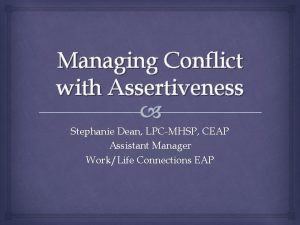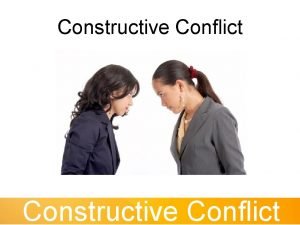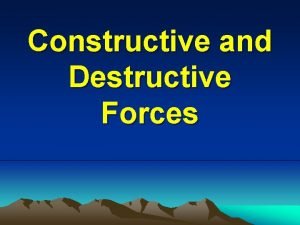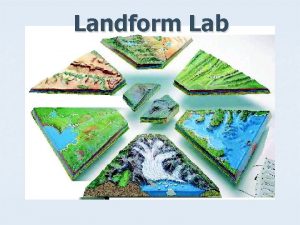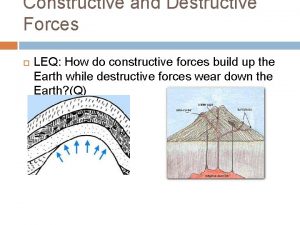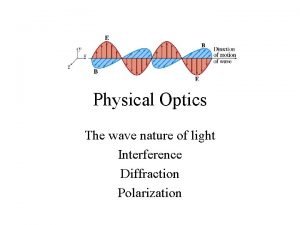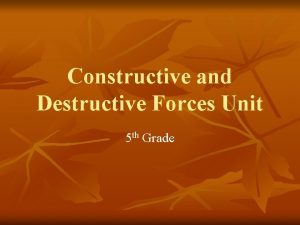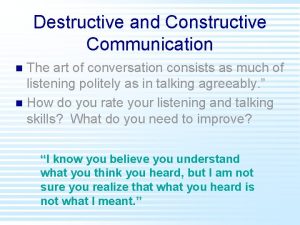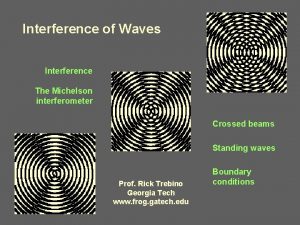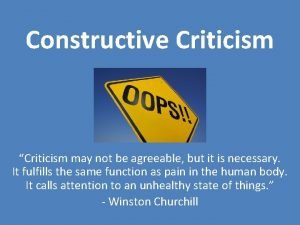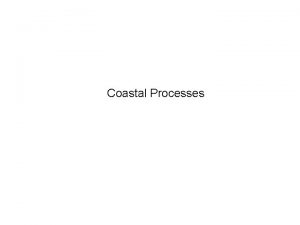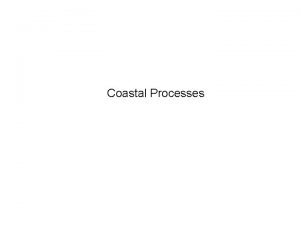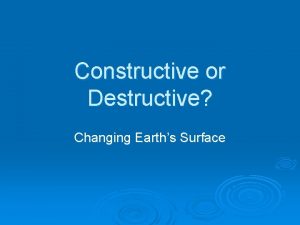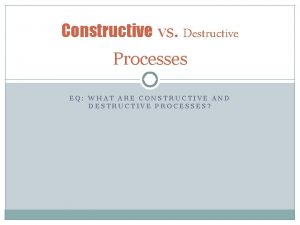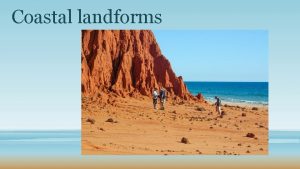Coastal Processes and Landforms CONSTRUCTIVE DESTRUCTIVE WAVES When












- Slides: 12

Coastal Processes and Landforms

CONSTRUCTIVE DESTRUCTIVE WAVES When the swash is bigger than backwash material gets pushed up to the back of beaches rather than removed. This steepens the beach profile. These waves are called CONSTRUCTIVE waves Where backwash is larger than swash more material is being eroded from the beach profile than is being accumulated. This carries material out to sea and makes for a gentler beach profile. These waves are called DESTRUCTIVE WAVES

1 b COASTAL EROSION

Erosion Processes 1. 2. 3. 4. Attrition Hydraulic Action Corrosion Corrasion / Abrasion

Attrition Material carried by the waves bump into each other and so are smoothed and broken down into smaller particles. Hydraulic action This process involves the force of water against the coast. The waves enter cracks (faults) in the coastline and compress the air within the crack. When the wave retreats, the air in the crack expands quickly causing a minor explosion. This process is repeated continuously. Corrosion This is the chemical action of sea water. The acids in the salt water slowly dissolve rocks on the coast. Limestone and chalk are particularly prone to this process. Abrasion/Corrasion This is the process by which the coast is worn down by material carried by the waves. Waves throw these particles against the rock, sometimes at high velocity.

Coastal erosion processes create a number of significant landforms. There a number of factors which affect the rate of this erosion: i) Rock Type – A more resistant rock, such as granite, will be eroded slowly, whilst a less resistant rock, such as clay or mud, can be eroded very quickly. ii) Jointing / Faulting – The more faults and joints a rock has the more susceptible it is to erosion, both from coastal and sub-aerial processes.

Coastal Rock Arrangement – A coastline with rocks that run parallel to the coast is called a concordant or “Pacific” coastline. One that has rocks running at right angles to the coast is called a discordant or “Atlantic” coastline.


DISCORDANT COASTLINE Rocks are at right angles to the sea HEADLAND HARD ROCK SOFT ROCK BAY HEADLAND HARD SOFT

Discordant Coastline

Headlands and Bays - Formed on an Atlantic (discordant) coastline due to the softer rock being eroded quicker than the harder rock. - Beaches form in the bays where the soft rock has been eroded away. - Headlands of more resistant, hard rock are left behind.

Concordant Coastline ROCKS ARE PARALLEL TO THE SEA ARD ROCK BAY OFT ROCK BAY ARD ROCK EG Lulworth Cove, Dorset OFT ROCK ARD ROCK
 Difference between constructive and destructive waves
Difference between constructive and destructive waves Constructive and destructive conflict
Constructive and destructive conflict Constructive conflict
Constructive conflict How do constructive and destructive forces change earth
How do constructive and destructive forces change earth Are floodplains constructive or destructive
Are floodplains constructive or destructive Forces
Forces Apparent frequency formula
Apparent frequency formula Constructive and destructive interference
Constructive and destructive interference Constructive and destructive forces 5th grade
Constructive and destructive forces 5th grade Examples of destructive communication
Examples of destructive communication Are canyons constructive or destructive
Are canyons constructive or destructive Constructive vs destructive interference
Constructive vs destructive interference The difference between criticism and constructive criticism
The difference between criticism and constructive criticism

